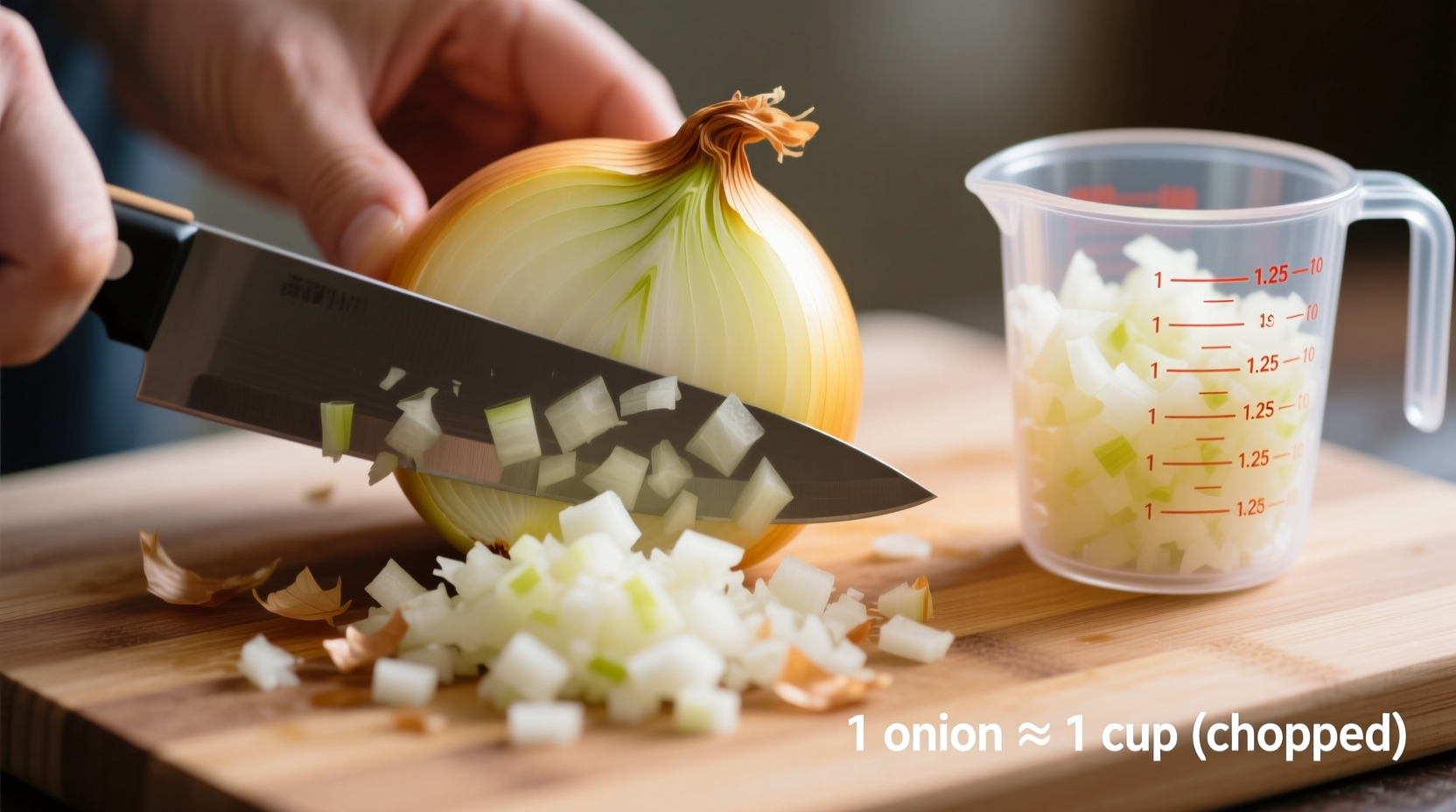Understanding precise onion measurements transforms your cooking accuracy and recipe success. Whether you're scaling a family recipe or following a chef's instructions, knowing exactly how much volume one onion provides eliminates guesswork in the kitchen. This guide delivers professional chef-tested measurements you can rely on for consistent results every time.
Onion Size Classification System
Before converting onions to cups, you need to identify your onion's size category. Unlike standardized produce, onions vary significantly in size, affecting their cup yield. Here's how professional kitchens classify them:
| Size Category | Diameter | Weight Range | Chopped Yield |
|---|---|---|---|
| Small | 2-3 inches | 3-5 oz (85-140g) | 1/2 cup |
| Medium | 3-4 inches | 5-8 oz (140-225g) | 1 cup |
| Large | 4+ inches | 8-12 oz (225-340g) | 1 1/2 cups |
This standardized classification comes from the USDA FoodData Central database, which culinary professionals use for consistent recipe development. The measurements reflect peeled, chopped yellow onions—the most common variety used in recipes.
How Onion Type Affects Volume Yield
Not all onions convert to cups equally. Different varieties have varying water content and density, changing their volume yield:
- Yellow onions (most common): 1 medium = 1 cup chopped
- Red onions: Slightly denser, yielding about 10% less volume than yellow onions
- White onions: Higher water content, yielding approximately 5% more volume
- Shallots: Much denser, requiring about 3-4 shallots to equal 1 cup chopped

Factors That Change Your Onion Measurement
Several variables affect how many cups one onion produces. Understanding these context boundaries ensures accurate measurements:
Chopping Technique Matters
The size of your dice significantly impacts volume:
- Fine dice (1/8 inch): Yields about 10% less volume due to tighter packing
- Medium dice (1/4 inch): Standard measurement used in most recipes
- Rough chop: Can yield up to 20% more volume with air gaps between pieces
Moisture Content Variations
Seasonal factors affect onion water content:
- Fall-harvested onions: Typically drier, yielding slightly more volume
- Sprouting onions: Higher moisture, yielding less usable volume
- Refrigerated storage: Can reduce moisture content by 5-8% over two weeks
Professional Measurement Techniques
Follow these chef-approved methods for precise onion measurements:
When Precision Matters Most
For baking, canning, or preserving where ratios are critical:
- Peel and roughly chop your onion
- Press chopped pieces gently into measuring cup with back of spoon
- Level off excess with straight edge
- For critical recipes, weigh instead: 1 cup chopped yellow onion = 160g
When Approximation Works
For soups, stews, and sautés where exact measurements matter less:
- Use the "knuckle method": Chop until pile reaches first knuckle of your index finger
- Compare to common objects: A medium chopped onion fills a standard baseball
- Remember the 3:1 rule: Three medium onions fill a standard quart container
Recipe Conversion Guide
Adjust recipes confidently when your onion size differs from recipe specifications:
| If Recipe Calls For | But You Have | Use This Amount |
|---|---|---|
| 1 cup chopped onion | Small onions | 2 small onions |
| 1 cup chopped onion | Large onions | 2/3 of one large onion |
| 1 medium onion | No fresh onions | 3 tablespoons onion powder or 1/2 cup frozen chopped |
According to America's Test Kitchen research, frozen chopped onions yield about 15% less volume than fresh due to moisture loss during processing. When substituting, add 1-2 teaspoons of water to compensate.
Troubleshooting Common Measurement Issues
Solve these frequent onion measurement challenges:
"My chopped onion looks less than 1 cup!"
This happens when onions are finely diced or when using denser varieties. Professional kitchens address this by:
- Using the "shake and settle" method: Fill cup, shake gently, then add more
- Measuring before peeling (1 medium whole onion = about 1 1/4 cups chopped)
- Using weight measurements for critical applications (160g = 1 cup)
"How do I measure sliced onions?"
Sliced onions create more air space than diced:
- 1 medium onion sliced = approximately 1 1/4 cups
- For caramelizing, measure after slicing as volume reduces during cooking
- When recipes specify "thinly sliced," expect 20% more volume than standard slices
When Cup Measurements Don't Tell the Whole Story
Some cooking applications require understanding beyond simple volume:
The Flavor Concentration Factor
Spring onions have milder flavor than storage onions of the same volume. When substituting:
- Use 1 1/4 cups spring onions for every 1 cup yellow onions called for
- For intense flavor dishes, reduce volume by 25% when using red onions
- When using sweet onions like Vidalias, increase volume by 20% for equivalent flavor
Cooking Method Considerations
How you'll use the onions affects ideal measurements:
- Raw applications (salsas, salads): Measure after chilling for most accurate volume
- Sauteing: Onions reduce by 30-40% during cooking, so start with more
- Caramelizing: Expect 60-70% volume reduction; start with double the final amount needed
Practical Kitchen Reference
Keep these quick-reference conversions handy:
- "One onion" in recipes = medium yellow onion = 1 cup chopped
- "Small onion" = 1/2 cup chopped = 80g
- "Large onion" = 1 1/2 cups chopped = 240g
- "Shallot" = 1/8 cup chopped = 20g (about 1 large shallot)
For recipe scaling, remember that onion measurements don't scale linearly. When doubling recipes, increase onions by only 1.8x to prevent overpowering other flavors. This principle, documented in the Culinary Institute of America's recipe development guidelines, accounts for how flavor compounds interact at different concentrations.











 浙公网安备
33010002000092号
浙公网安备
33010002000092号 浙B2-20120091-4
浙B2-20120091-4